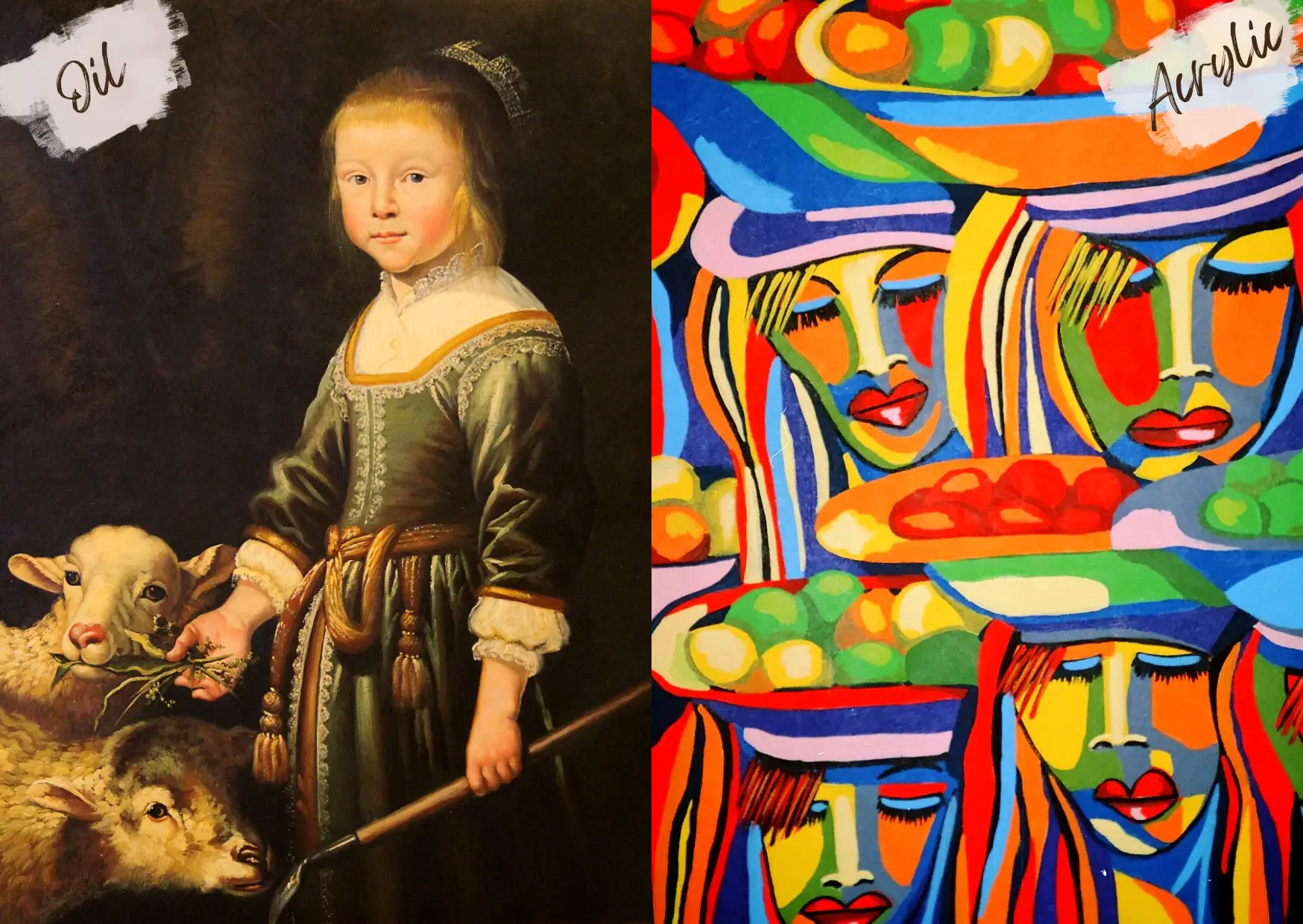Acrylic paintings can made to be look like anything. They can look like acrylics themselves, like oils sometimes, and also like watercolors. Because of its versatility, it is harder to recognize acrylics in a painting. So you might wonder, how to tell if a painting is acrylic?
In general, acrylic paintings are more opaque and have a matte and flat finishing with less blended, sharp, and visible brushstrokes. Smelling is one of the best ways to distinguish an oil painting from an acrylic painting, as acrylic paint can be manipulated to look like oils.
Recognizing the paint medium gets harder when the painting is varnished. But still, there are some tips and tricks you can use to differentiate an acrylic painting from others. I have included several best methods that you can use to identify an acrylic painting among others.
How can you know if a painting is acrylic?
Knowing if a painting is acrylic is important if you are planning to gesso over, when buying a painting, and maybe to feed your curiosity in an art gallery. In either case, there are some signs you need to look for as well as tips that you can follow to tell if a painting is an acrylic. I have included them all below.
Acrylic paintings are mostly done on canvas or wood panels. The other paint medium that uses the same surfaces and looks similar to acrylic paintings is oil paintings. So in most cases, you will need to differentiate an acrylic painting from an oil painting which is the hardest. Therefore, I will be giving tips to differentiate an acrylic painting from an oil painting throughout this article.
Acrylic paintings have less blended sharper brush strokes
This is one of the main aspects you can use to distinguish an acrylic painting. Acrylic paintings usually have less blended, sharper brush strokes. You will see the brush strokes in the below acrylic painting well. More so, it is the technique of the artists, to paint more loosely rather than being hyperrealistic.

As you can see these brush strokes are flatter and usually thinner. You will also notice that the edges of the shapes of acrylic paintings are sharp and crisp.
If you compare acrylic paintings with oil paintings, they have smoother less obvious brush strokes. Because oil paint can be blended well as they take a long time to dry. Oil paintings are usually three-dimensional (again depending on the intention of the artist) and thicker due to the building up of layers.
Acrylic paintings have saturated, vivid, and vibrant colors
You will also notice that acrylic paintings have saturated, vivid, and vibrant colors. As the layers do not mix like with oil paints, the colors will stay vibrant and vivid with acrylic paints. Some artists prefer these bright, vibrant colors while others do not. It can easily be changed with the color palette you use.
The reason why acrylic paints remain vivid and vibrant is that they are fast drying. As said before acrylic paint will not mix with the paint layers underneath. It will remain the same saturated, vibrant color you have applied without being muddy by mixing with the layers underneath.
The reason why oil paintings are darker and less vibrant is that they can easily be blended with the paint layer underneath as oil paints take more time to dry. Again this depends on the artist’s intention. Oil paintings can absolutely be made to be very vibrant like acrylics, although it is not very common.
Oil paintings have a vibrancy, sheen, and depth in colors that cannot be replicated with acrylic paint. Oil paint can hold more pigments than acrylic paint. Because you can combine more pigment with oils than in an acrylic polymer emulsion as with acrylic paint.
The acrylic paint film is organized in a honeycomb structure with pigments trapped inside it, but oil paint film is one singular mass that is a combination of drying oil, most commonly linseed oil, and loads of pigments.
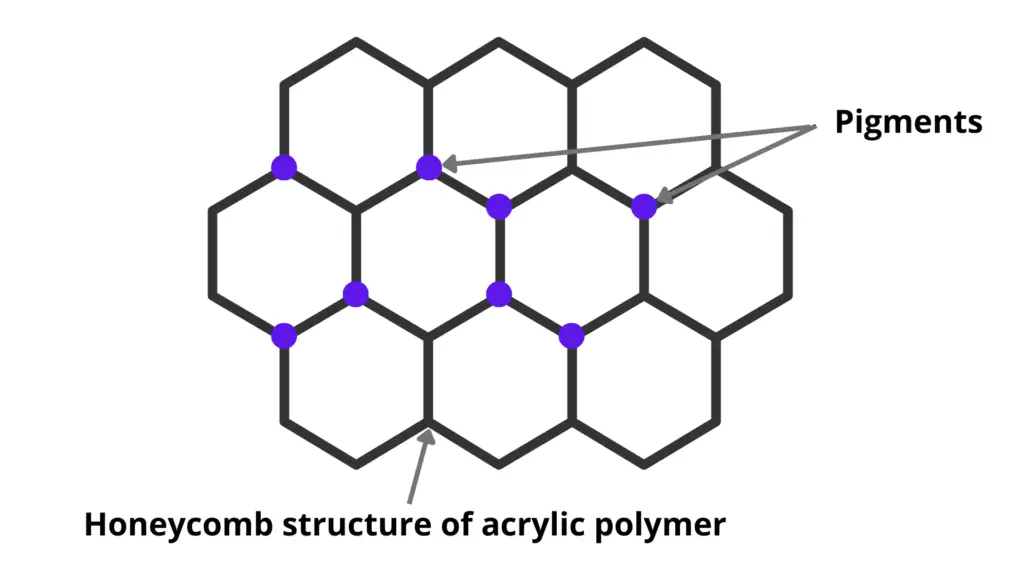
The chemical structure of acrylic paint is the reason why acrylic paint adheres to itself (when building layers) as many other surfaces. However, oil paints have a harder time adhering. It has a harder time adhering to dried oil paint unless you have absorbency or a chemical bond like with lead.
Acrylic paintings have a matte/ satin finishing
Acrylic paintings when dry mostly have a matte finishing. However, they are said to have a satin finishing which is between matte and gloss.
But oil paintings are naturally shinier compared to acrylic paint, because of the oils and ability to add more smooth and delicate paint layers together. Also, oil paintings have vibrant and true colored pigments oftentimes.
However, if acrylic painting is varnished it becomes harder to tell if it is acrylic from the shine, as oil paintings can shine too. When the acrylic painting is varnished, all colors of the painting come to a similar shine and vibrancy to make one cohesive painting.
Some artists say that they did not see a matte finish in their acrylic paintings. This is mostly true as acrylic paints usually have a statin finishing although we see it as a matte finishing most of the time. Also, it is important to note that acrylic comes in metallic colors, iridescent mediums, and gloss mediums as well. These will make acrylic painting shiny regardless of varnishing.
Also, oil paintings can have a matte finish if you use matte oil paints. But in most cases, oil paints are shiny while acrylic paints are matte or satin in an unvarnished painting without a glossy medium.
Acrylic paintings have almost no scent or smell
Smelling the scent of the painting is one of the most preferred methods among artists to distinguish between a water-based painting and an oil-based painting. If you are getting a strong scent from a painting it is most likely an oil-based paint or oil paint.
Acrylic paint does not have compounds that give rise to odor and scent. But if you smell an acrylic paint tube you will get a very faint odor usually coming from ammonia or the preservatives used.
The scent of oil paintings is given by the solvents and mediums like natural oils used in oil paints. The odor of mineral oils or solvents gives most artists headaches. So, there are odorless paint thinners that can reduce the odor of solvents.
However, if you did not smell anything from the painting, the painting is most likely water-based paint like acrylics. You may get a very faint smell from acrylics but not as much with oil paint. But if a solvent-based varnish is used for an acrylic painting (like a removable varnish or a spray varnish), you will also smell acrylic painting. But still, you will be able to distinguish an oil painting from the smell of natural oils.
Acrylic colors in paintings are mostly opaque
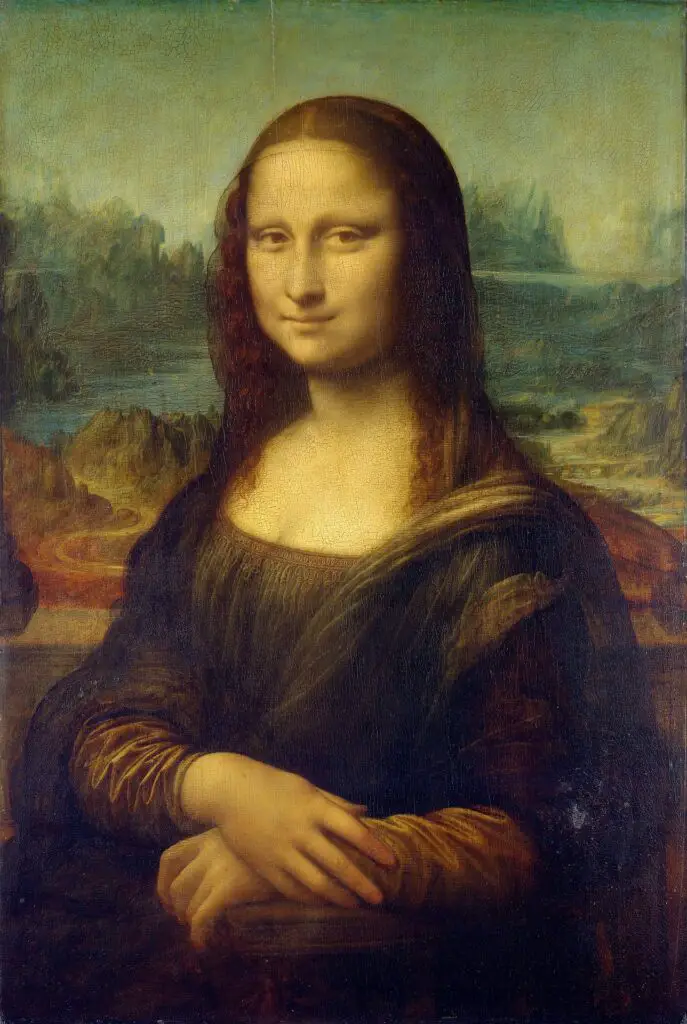

Acrylic paintings as you can see in the above image also are opaque and at the same time flatter. But oil painting is a collection of many delicate, transparent, and glaze-like paint layers. Because of this oil paintings usually looks more smooth, and delicate but more in-depth.
For the most part, it is harder for another paint medium to completely replicate the delicate, velvety, smooth, and in-depth nature of oil paintings. Look for more bright and opaque colors to distinguish an acrylic painting. It will be easier when you train your eyes more.
However, as acrylic paints are so versatile you can manipulate them as you like. The main reason why acrylic paintings look flat with sharp edges is that they are fast drying. Now artists can use acrylic paint retarders to keep acrylic paint workable for a long time.
Also, you can build delicate transparent layers of acrylic paint by using a glazing medium or a matte or gloss acrylic medium. It is a must-have if you are painting a still life or a realistic painting with acrylic paint. This way you can make a painting with acrylic that looks like a really good oil painting.
Following is a still-life painting I have done, it may be harder for the viewer to guess the paint medium as I have used glazing techniques and so many layers of acrylic paint in this painting.
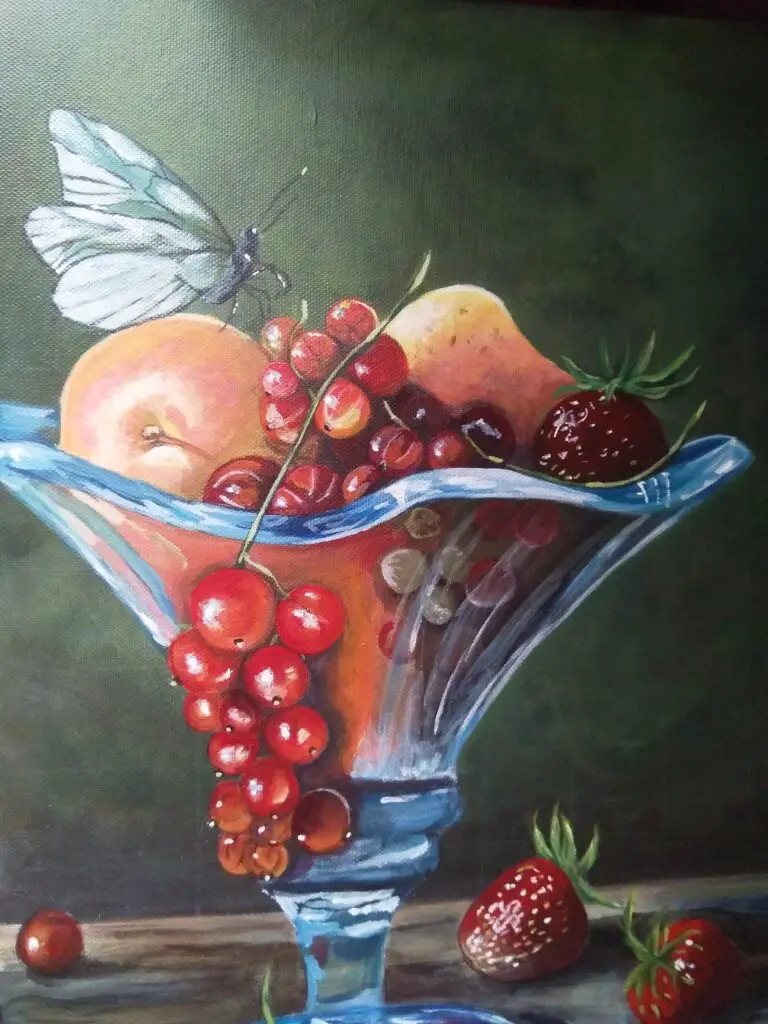
For the same reason, it will be harder to guess the painting medium of this painting. However, you can guess that is an acrylic painting by the brighter, opaque, and vivid colors used. This can again change with the artist if an artist used a muted color palette.
Oil paintings have signs of aging and microcracks
The oil paint film is nonflexible while acrylic paint film is a flexible, thin plastic layer. Therefore upon aging, acrylic paint will not crack and will not also be yellowing. Oil paintings will yellow and mildly break over the years.
Yellowing happens due to the aged varnish. These are usually found in old masters’ paintings. Old oil paintings were often hung in damp, or hot, smoky industrial areas which contributed to the .yellowing and cracking of the varnish.
Even though oil paintings are yellowed, the original colors with original intensity can be restored with cleaning solutions that are intended like emulsion cleaners and varnish removers. Sometimes you will be able to remove smoke damage from an oil painting with damp cotton wool, but not old varnish.
You’ll need to follow the proper cleaning process if thinking about repainting, otherwise, there is a risk of paint peeling off as new paint dries and ages.
Oil paintings when aging has micro cracks. You can see them in famous old oil paintings like Mona Lisa when looked very closely. This is not visible with acrylic paint because acrylic paint film can hold small stretches and shrinking of the paint film as it is a flexible plastic.
Oil paint is no such plastic but an oxidized and hardened film of oils, solvents, and pigments when exposed to air. However, oil paintings last for centuries and decades as same as acrylic paint.

Also if you are looking at a painting much older, like older than the first world war (July 28, 1914 – November 11, 1918), it is most likely an oil painting. However, artists in the early days also used tempera or egg tempera paints in paintings as well. An example is Sandro Botticelli’s, The Birth of Venus (tempera on canvas, c. 1486).
Acrylic paint didn’t come into wide use until the latter half of the 20th century. If you want to know about famous and professional artists who used acrylic paint, your can read my article; Do professional artists use acrylic paint? (with examples)
Acrylic painting in general dries in a few minutes
If you want to differentiate a painting from a short-after painting, it will be much easier. Acrylic paint layers of normal thickness dry within 20 minutes, while thicker acrylic paint layers dry within a few days to weeks.
Oil paintings take a much longer time to dry. It takes weeks and even months to dry one layer of oil paint with normal thickness. You will need to have much patience to work with oils otherwise it is easy to ruin an oil painting.
So if you see a painting that is taking weeks or months to dry, most probably it is an oil painting and not an acrylic painting. However thicker acrylic paint layers take days or weeks to dry. You need to keep in mind the environmental factors that affect the drying process; high humidity and low temperatures slow down the drying process.
If you are interested to know more about factors affecting acrylic paint drying you can read the following article; How long for acrylic paint to cure? (Comprehensive answer).
Most acrylic paintings are smooth and flat
Most acrylic paintings we see are smooth and flat. The flat look is given by the matte/ satin finishing of acrylic painting. But if you varnish the painting, the flatter look will be reduced as the colors of the painting pop out more.
But oil paintings are often textured and thick, due to multiple layers of oil paint. Oil paintings are thick in highlights and thin with shadows. However, the thickness and texture of acrylic paintings can be manipulated using acrylic mediums like gels and pastes.
Acrylic paintings are realistic but not in more delicate scenes
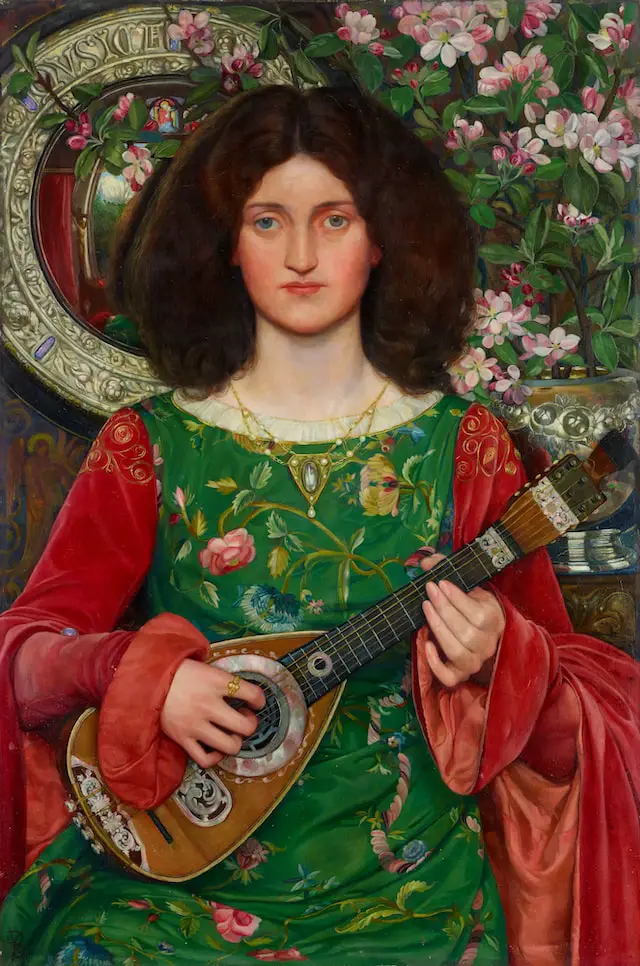
Acrylic painting can be used to create more realistic scenes, because of its’ versatility. However, it is incredibly hard to achieve the delicacy and softness in a portrait painting of a human as with oil paints. However, with oil paint, you can create more complex yet velvety like nature in a painting.
It is visible in the oil painting Musica I have included above. In that painting, done with oil on canvas, you could see the softness of the flesh, fabric, and in-depth details of the elements surrounding the subject. This is harder to achieve with acrylic paint. With oil paint, you could build so many layers showing more realistic lighting, glow, and texture.
Acrylic paint is most known used for loose, abstract paintings rather than more realistic paintings. However, you can paint more loosely and abstractly as acrylic paint with oil paints also. In this case, look for the soft edges or the delicate blending of paint to distinguish between oil and acrylic paint.
Using solvents to distinguish between paintings
Some suggest using a solvent to distinguish between paintings. However, I do not recommend this method as it can damage the painting. You can try these different solvents at the sides or edges of the painting.
Acetone can be used to differentiate between oil-based and water-based paint. Acetone dissolves water-based paint like acrylic paint. Take some acetone onto a small rag and rub it on a corner of the painting in a minimally invasive way. If it is an acrylic painting paint will come onto the rag, if oil-based, the paint will not come off.
Some suggest using an oven cleaner solution as it only removes oil paint but not acrylic paint. This is not much of a reliable method as formulations of the oven cleaners can change.
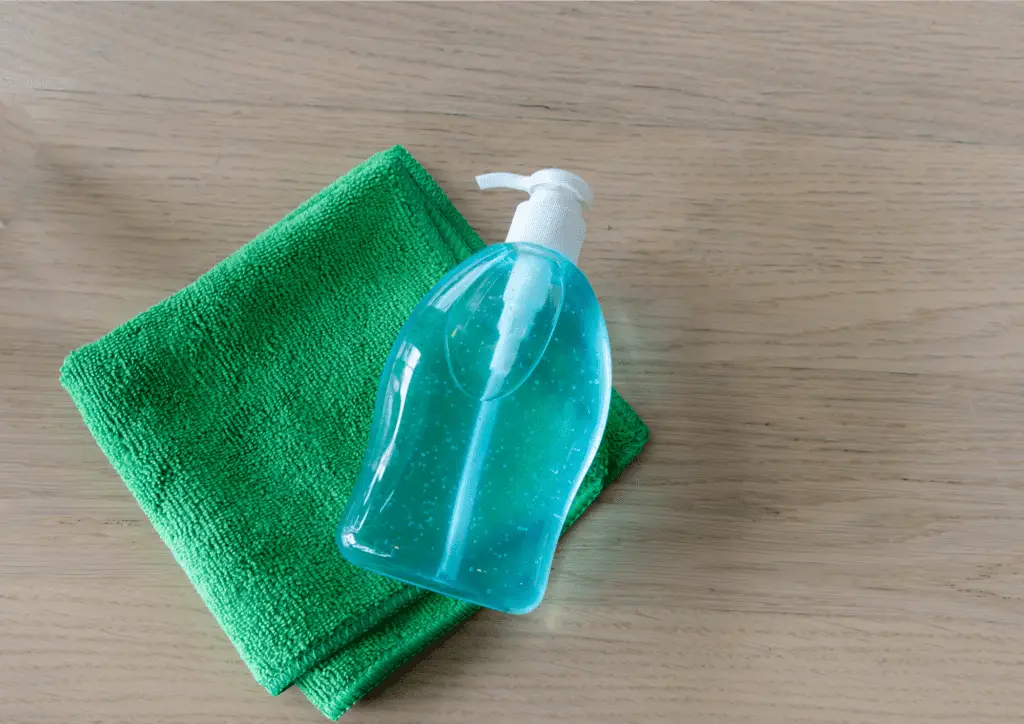
I have seen some people suggest using alcohol to distinguish between oil and acrylic paints. But this is not essentially true. If you use a high percentage of alcohol it will easily strip away both oil-based and water-based paints like acrylic. Therefore do not use alcohol to differentiate the two paintings.
Still cannot distinguish acrylic paintings?
If you still cannot distinguish acrylic painting from others, there is nothing to worry about. One simple and obvious way you can know the painting medium for sure is by asking the artist. Also when you see many paintings using different mediums you will develop an instinct to differentiate between paint mediums. But still, it can go wrong.
Some artists use different mediums in the same painting, called mixed media painting. They may start with acrylic paint and end up with oil paint. Sometimes you may only use acrylic paint but after varnishing it may look like an oil painting.
So, if you want to know for sure if a painting is an acrylic always ask the respective artists. If it is an old, famous painting, look for reliable information on paint medium in literature. In other cases, use the metrics described above to guess the paint medium to the best of your ability.
Conclusion
All paintings have their own beauty and their own fans, no matter what the art medium is. It is harder to distinguish between oil and acrylic paintings in most cases. However, you will easily be able to recognize a watercolor painting with its transparent layers on paper. Tempera is not very commonly used for professional art these days. Also, gauche is used on paper for temporary artwork that is intended to reproduce.
I have written a whole article comparing all the water-based paints to acrylic paint. You can find a detailed comparison of each water-based paint and acrylic paint including a nice summary with a handy chart.

